Tips for choosing a kitchen sink siphon
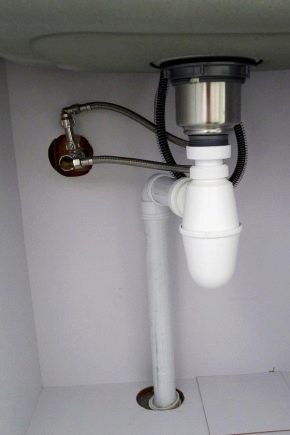
The siphon in the kitchen is the main part of the drainage system. It not only removes dirty water from the sink, but also prevents unpleasant odors from drains inside the apartment. Additional functionality is considered to be the protection of the plumbing device from overflow. This is made possible by the kitchen sink unit with overflow.
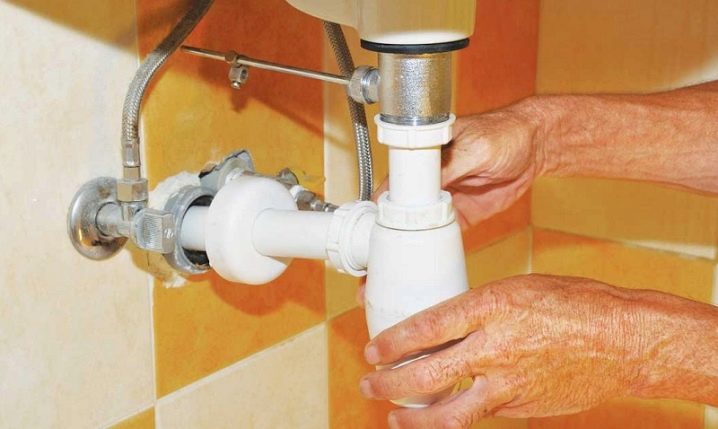
Peculiarities
Reliability and performance depend on the design characteristics. In this matter, it is necessary to exclude orientation only to the appearance of the product: it will be used daily, also in an aggressive environment. Siphons are installed in various plumbing equipment:
- bathroom;
- soul;
- kitchen sink;
- sink for washing;
- in the toilet;
- in household appliances.
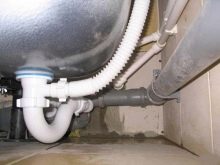
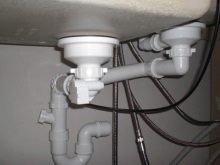
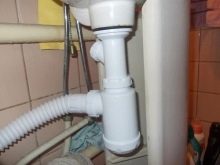
The sink trap is usually more durable than other options. The material is selected to be resistant to different temperature environments. It is often necessary to use a very hot liquid to rinse the grease off the dishes. At the same time, the device must contain bulk solids, otherwise they will fall into the pipes, due to which the pipes will quickly become clogged. In the kitchen, household appliances are often connected to the sewer pipes: washing machines or dishwashers. They require branched systems with a water seal, which allow you to connect all the necessary devices at the same time.
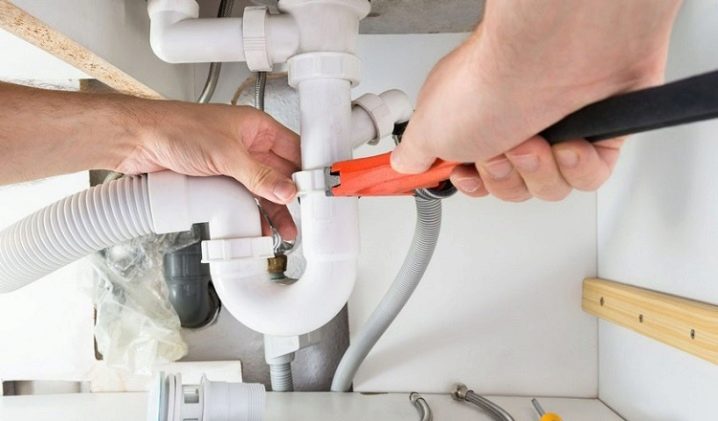
Sometimes it is allowed to use shower or bath systems under the kitchen sink. The first option is flat, so it frees up a lot of space under the sink. The second option is equipped with an overflow system. This comes in handy when you need to fill your kitchen sink with water. The whole system is made up of two connecting branches: for overflow and drain. The washbasin siphon can also be adapted to the kitchen sink. It is characterized by its compactness and the presence of a curved corrugated tube, which saves space.
The only option that is not suitable for a kitchen sink is a toilet siphon. It is a curved drain that is built into the plumbing fixture. It plays the role of a water seal: it also contains water, which helps to eliminate unpleasant odors.
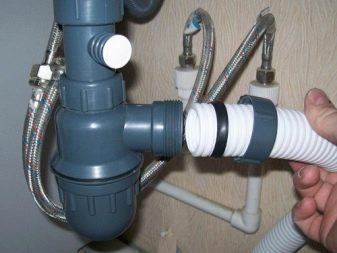
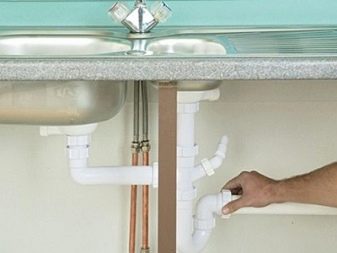
Principle of operation
The classic siphon is a bent pipe, the elbows of which differ in different lengths. Water from the vessel located above enters the vessel below. For performance, the level of the liquid matters. Therefore, it must first be filled with water. The physical properties of a liquid substance underlie the principle of the siphon. Water is constantly at the bottom of the curved outlet of the appliance. Due to the curved shape, pressure is maintained inside. The drains are renewed, thereby preventing the entry of unpleasant odors into the room. Waste water flows into the siphon every time it is used.
For example, from a sink, liquid flows into the outlet of the structure. Then the water flows into the bottle and leaves through the connecting branches. Then the liquid enters the outlet compartment, and from here into the sewer pipes.
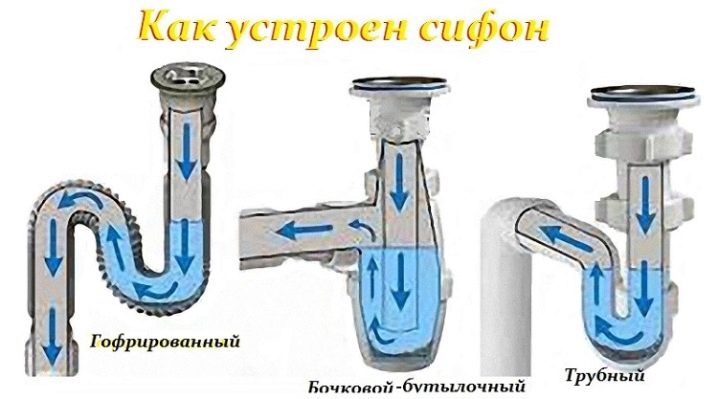
The siphon design includes:
- outer part;
- insulating socket;
- branch connecting to the sewer;
- sewage sump;
- sealing gasket;
- corner gasket;
- filter grate;
- connecting screw.
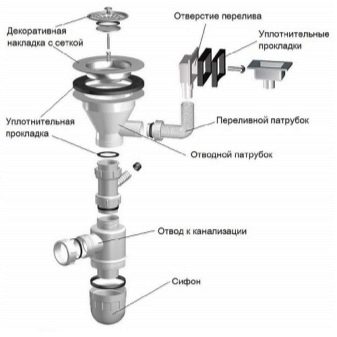
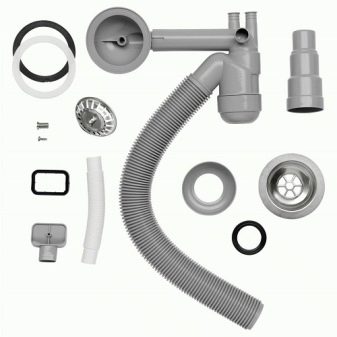
Structurally, siphons may differ, but the devices have an identical purpose.In addition to the design, the materials that the manufacturer uses in production may vary.
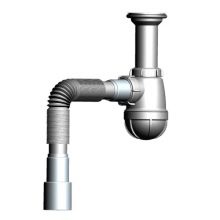
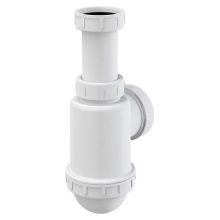
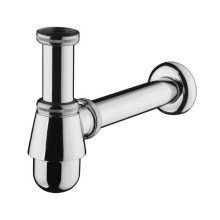
Dimensions (edit)
If the dimensions of the siphon and the sewer pipe do not match, the connection may cause certain inconveniences. Another extremely important indicator is its throughput. Of the dimensions, in addition to the diameter of the pipe, the distance between the sewer outlet and the plumbing fixture matters. The standard height of a plumbing fixture is 70–80 cm. As a rule, a straight piece, called a branch pipe, is enough for connection, but there are exceptional situations. In this case, additional adapters will help. They are needed when the sewer outlet is not opposite the siphon. In these cases, bottle versions with flexible corrugated tubing or compact models are recommended.
In most cases, the sewer inlet under the washbasin is mounted at a height of 50–55 cm. The inlet pipe diameter varies from 32 to 90 mm. The siphon connection must correspond to the value or be less. An adapter is required for larger diameters. It is also needed for custom Blanco plastic products for kitchen sinks or other models. For example, if the sink in the kitchen is equipped with a pedestal, the siphon inside will not be visible, as it has a compact size.
For sinks without a pedestal or design options, you will have to spend money on an expensive device, the external type of which will match the plumbing.

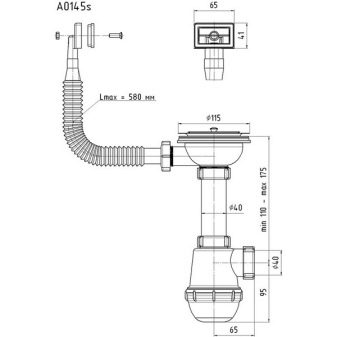
Manufacturing materials
The first historical material for siphons was cast iron. Later, graceful bronze and brass models appeared. These technological products are still very popular today. The chrome-plated siphons are reliable and do not rust. Plumbers do not recommend such products, as a layer of oxides quickly forms inside. Rubbish clings to it, siphons quickly clog up and fail. Steel options are recognized as more reliable and convenient in comparison with bronze and brass products. The devices are very expensive, so if you do not need a design sophistication, you can choose a plastic or plastic siphon.
Plastic products are classified into polypropylene and polyethylene options. Both those and other options are practical, do not rust or rot, and retain their throughput for a long time. Modern models are white, black or even colored. And also there are shiny options, the coating of which is no different from bronze or brass. Any kind of plastic products are easier to install. The main disadvantage of these products is frequent breakdowns due to sudden temperature changes. The joints are especially affected, which can simply collapse.
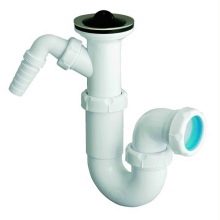
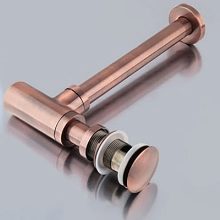
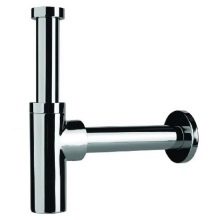
Types and their purpose
Any siphon must correspond to its purpose, which means, in addition to the materials of manufacture, you also need to know the types of products. Even if a siphon design is chosen for a kitchen sink, products are still classified by type. The following samples are on sale:
- pipe;
- corrugated;
- bottle;
- closed.
Continuous cleaning is easy: just unscrew the flask and shake out the debris.
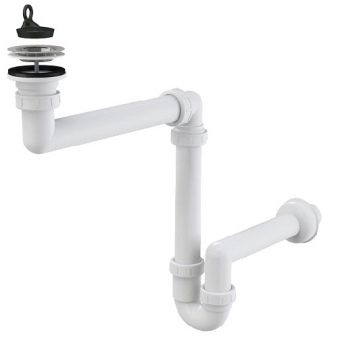
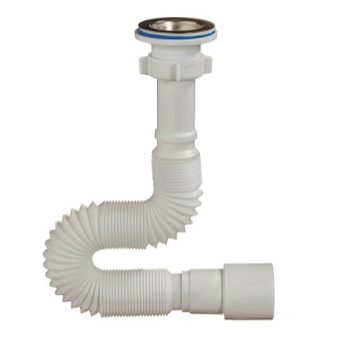
Conventional siphons do not fit well with beautiful designs. For them, there are plumbing fixtures in boxes. They are installed in a hidden sewerage system, which is usually located in a niche. Siphons in a box are needed for stone and cast iron sinks. A box made of artificial stone looks beautiful and expensive.
There are also branched models that allow you to solve complex plumbing problems. The branched system allows you to connect to multiple sinks. For example, it is suitable for built-in sanitary ware with side outlet or for several washbasins. The siphon, equipped with branches, is suitable for washing machines and dishwashers. The siphon chosen should be suitable not so much for the design as for the specific purpose. The choice of fixtures and components, which must correspond to certain types of sinks, is considered important.
Popular manufacturers produce items complete with these plumbing fixtures.
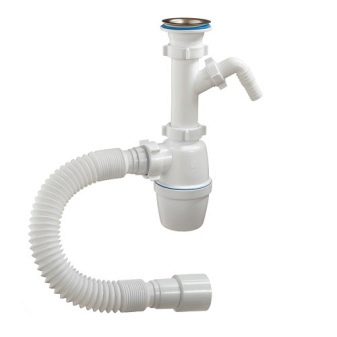

Popular manufacturers
The top ten popular manufacturers of siphons and plumbing devices include:
- Viega;
- Orio;
- AlcaPlast;
- MCAlpine;
- HL;
- Geberit;
- Blanco;
- Wirquin;
- Suntek
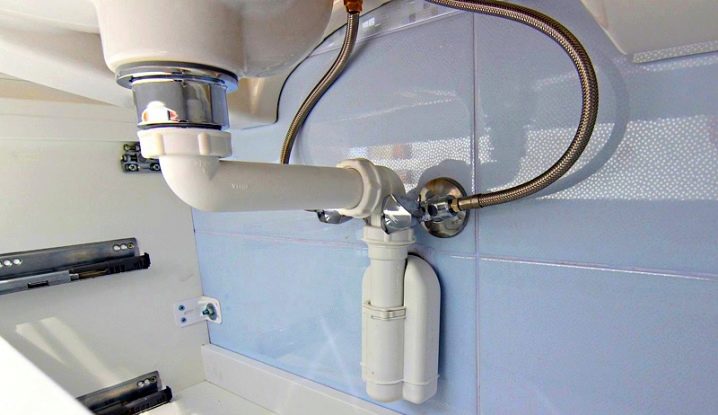
The first manufacturer from the list from Germany is engaged in the production and sale of various engineering equipment. The assortment is extensive - about 17 thousand items. The products have been nominated and awarded more than once in the field of design and technology.
- Viega siphons - this is not only a premium class, but also ordinary budget models that are of high quality. The second from the list is a domestic manufacturer supplying low-cost product options to the market. The products are environmentally friendly and have a long service life. The assortment of products is large and varied.
- AlcaPlast Is a Czech brand known on the market since the 90s. The range of branded products is small, but the main criteria of the company are design and quality. The latest innovations meet the criteria of manufacturability and are equipped with modern automation. MCAlpine manufactures a wide range of plumbing fixtures and fittings. The firm is English, has an extensive dealer network around the world. The products are one of the most counterfeited among other competitors. Manufacturers even offer a memo to buyers, according to which the original can be distinguished even by its packaging.
The manufacturer also draws attention to the fact that low-quality polymers smell unpleasant.


- Hutterer & Lechner branded products presented on the market as innovative. It is believed that individual plumbing units can be combined with different pieces of equipment, all parts are interchangeable. Mounting of many models is convenient thanks to special hinge mechanisms.
- Geberit Is a Swiss company specializing in the production of plumbing fixtures and sewerage systems. The devices are characterized by increased attractiveness and reliability.
- Blanco Is another German manufacturer on this list. The company supplies the market with various models from the most budgetary to the most expensive. The range of models is very diverse. At the same time, one type of siphons on the market can be made of different materials. The buyer is immediately given the opportunity to compare products.
- Wirquin Is a French company that offers customers a variety of products. The company unites several factories located in different countries. The main product criteria are reliability and quality.
- Suntek - a Russian manufacturer that offers inexpensive devices for various types of plumbing devices. The company manufactures its products from plastic, all products are provided with a 10-year warranty.
- Jimten Is an Italian company known on the world market for many years. Italian plumbing has long been synonymous with quality, and Jimten only confirms the statement.
Branded products are durable, reliable in installation, modern design.
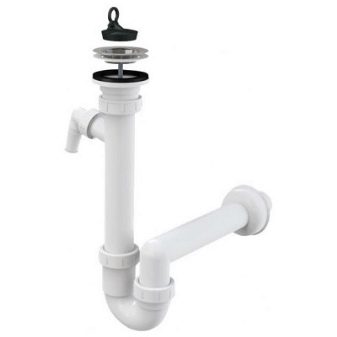
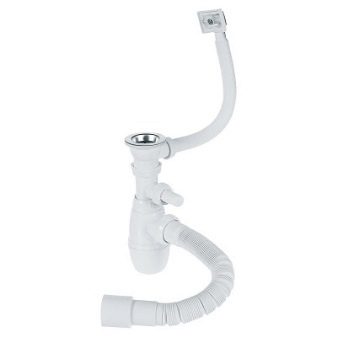
Selection Tips
To prevent mistakes, you should heed some advice on choosing.
- An incorrect purchase decision may result in the purchase of not all parts of the device. It is better to select the entire kit at once, as well as the necessary materials and tools.
- Think about which modification is suitable for solving your problem. For example, if you need more space under the sink, it may be better to choose a flat siphon.
- The basic capabilities of a simple model can be expanded by functional adaptations. Plugs and shields may be needed to simplify operation. Plugs are useful for branched devices to which you plan to connect equipment.
- If installed incorrectly, kinks of the corrugated pipes often occur. This interferes with the normal movement of the fluid, causing blockages in the system. The plastic parts of the siphon can be damaged from hot surfaces or vibrating equipment.
- If, when buying, you compare models of the same functionality in price, choose those materials that correspond to your understanding of durability.
- If the siphon is planned to be placed in a closed space, it makes no sense to purchase expensive design models.
- Installation of equipment is carried out in accordance with the accompanying documents.
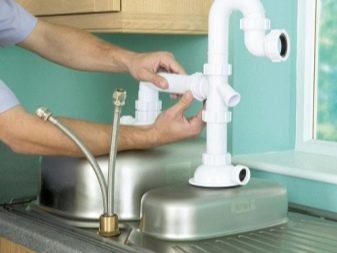
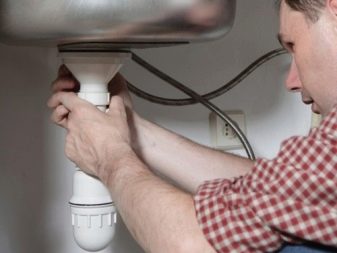
Assembling the device
Instructions for assembling the device are supplied with the device, which is complete with:
- filter;
- additional sections of pipes;
- stopper;
- chopper;
- button;
- two ramifications.
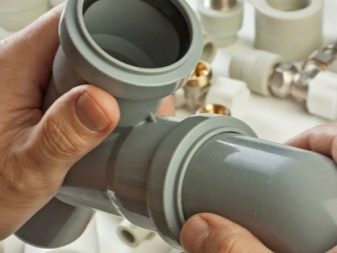
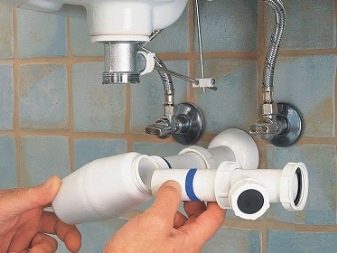
Let's take a closer look at the installation of a conventional bottle version with a large opening and a wide neck. The sequence of actions is as follows:
- take a large thin gasket and place it over the siphon body where the threaded connection is;
- tighten the bottom plug;
- put a union nut on the outlet to the sink;
- put a conical washer on the lower outlet: with its help it will be possible to change the position of the parts in further operation;
- connect the outlet to the cone and tighten the nut;
- connect the outlet pipe to the drain pipe: first, the nut is fastened to the pipe, then to the conical washer, then to the body and another nut.
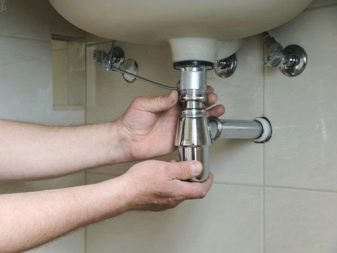

After completing the assembly of the siphon, you can begin the stage of connection with the sink and pipe. The pipe must be fitted with a rubber gasket. There should also be a gasket on the drain hole of the sink. A mesh is mounted on top of it, and the siphon itself is fastened with a screw. The drain hose of the siphon is connected to the sewer. In some cases, for example, if the product is corrugated, it is inserted into the outlet pipe of the system. At the final stage, you need to turn on the tap and check if the system is leaking.
If there is a leak, it is better to eliminate it immediately by tightening certain elements of the siphon.
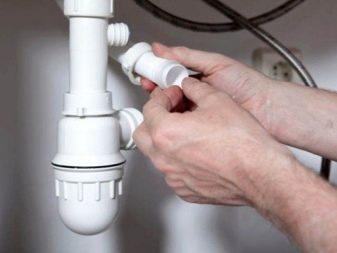
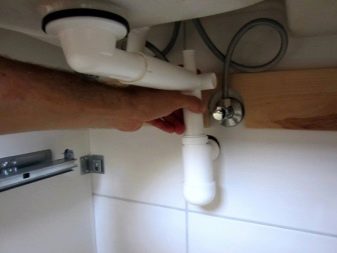
How to install a siphon on a sink and sink with your own hands, see the video below.













The comment was sent successfully.